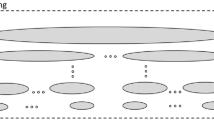Abstract
Different communities deal with the use of object-oriented (O-O) ideas for requirements engineering. Their views are different and many misunderstandings are around. Although O-O approaches are the most widely used in practice apart from pure natural language, there does not seem to be much interest in the scientific treatment of open issues in this regard. This article argues for taking such issues up (again).

Similar content being viewed by others
Notes
ACM SIGPLAN conferences on object-oriented programming, systems, languages, and applications; for the upcoming conference see http://www.oopsla.org/2004/.
IEEE international requirements engineering conferences; for the upcoming conference see http://www.re04.org/.
Annual symposia of the international council on systems engineering; see http://www.incose.org/.
Journals named Requirements Engineering (see http://rej.co.umist.ac.uk/) and Systems Engineering (see http://www3.interscience.wiley.com/cgi-bin/jhome/39084.)
At the time of this writing, the specification of UML is available at http://www.omg.org.
References
Davis AM (1993) Software requirements: objects, functions, and states. Prentice Hall, Englewood Cliffs, New Jersey
Davis AM, Hickey AM (2001) Requirements researchers: do we practice what we preach? Requirements Eng 7(2):107–111
Jacobson I, Booch G, Rumbaugh J (1999) The unified software development process. Addison-Wesley, Reading, Massachusetts
Kaffenberger R (2003) Will object-oriented systems-engineering reshape requirements engineering? In: Proceedings of the 13th annual international symposium of the international council on systems engineering (INCOSE 2003), Arlington, Virginia, July 2003, pp 583–595
Kaindl H (1997) A practical approach to combining requirements definition and object-oriented analysis. Ann Software Eng 3:319–343
Kaindl H (1999) Difficulties in the transition from OO analysis to design. IEEE Softw 16(5):94–102
Kaindl H (2001) A design process based on a model combining scenarios with goals and functions. IEEE Transact Syst Man Cybern (SMC) Part A 30(5):537–551
Larman C (2001) Applying UML and patterns: an introduction to object-oriented analysis and design and the Unified Process, 2nd edn. Prentice Hall, Englewood Cliffs, New Jersey
Author information
Authors and Affiliations
Corresponding author
Rights and permissions
About this article
Cite this article
Kaindl, H. Is object-oriented requirements engineering of interest?. Requirements Eng 10, 81–84 (2005). https://doi.org/10.1007/s00766-004-0197-1
Received:
Accepted:
Published:
Issue Date:
DOI: https://doi.org/10.1007/s00766-004-0197-1




